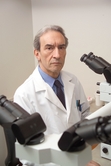Langerhans cell (eosinophilic) granulomatosis: A clinicopathologic study encompassing 50 years Journal Article
| Authors: | Lieberman, P. H.; Jones, C. R.; Steinman, R. M.; Erlandson, R. A.; Smith, J.; Gee, T.; Huvos, A.; Garin-Chesa, P.; Filippa, D. A.; Urmacher, C.; Gangi, M. D.; Sperber, M. |
| Article Title: | Langerhans cell (eosinophilic) granulomatosis: A clinicopathologic study encompassing 50 years |
| Abstract: | We summarize our experience with 238 cases of Langerhans cell granulomatosis (LCG), 198 of whom were followed for a median period of 10.5 years. Our patients did well unless overtreated, and no deaths were attributed to the disorder itself. The disease may appear in unifocal or multifocal form, and treatment is based on this fact. Virtually all patients recovered completely except for occasional residual orthopedic problems or residual diabetes insipidus. Several of the patients underwent subsequent pregnancies without difficulty. The granulomas primarily occur in bone, but lung, skin, and lymph nodal involvement is not uncommon. Involvement of thyroid, thymus, and other sites is rare. The hallmark of the disease is the accumulation of Langerhans cells (LCs). We review the pathology of LCG by histology, electron microscopy, and immunolabeling. LCs originally were identified in squamous epithelium, but these cells are part of the widespread system of dendritic cells. The latter cells, which arise from CD34+ progenitors, are specialized and efficient antigen presenting cells for T- cell-mediated immunity. In LCG, however, the major associated cells are not T cells, but mature eosinophils: hence the original name eosinophilic granuloma. Confusion about terminology has been based upon the scanty and rather crude pathology reports in the original literature. The term histiocytosis X was meant to cover a spectrum of three diseases-eosinophilic granuloma, Hand-Schuller-Christian disease (HSC), and Letterer-Siwe disease (LS)-but HSC and LS have no basis in pathology and hence the terms are meaningless. The term HSC has become a synonym for multifocal eosinophilic granuloma (LCG). The term LS has been used in reporting a number of benign, malignant, or unknown conditions. We prefer the term LCG to avoid confusion with the term histiocytosis X because there is evidence that the LC is not a member of the mononuclear phagocyte system and hence not a tissue macrophage, and because the use of the term 'histiocyte' has become a convenience in much of the literature when reporting incompletely understood diseases. |
| Keywords: | immunohistochemistry; adolescent; adult; child; controlled study; human tissue; preschool child; school child; treatment outcome; aged; child, preschool; middle aged; major clinical study; prednisone; clinical feature; methotrexate; follow-up studies; electron microscopy; tumor localization; cyclophosphamide; vincristine; diagnostic imaging; cause of death; infant; infant, newborn; daunorubicin; asparaginase; age distribution; vinblastine sulfate; eosinophilic granuloma; mercaptopurine; langerhans cell; exophthalmos; histiocytosis x; terminology; diabetes insipidus; histiocytosis, langerhans-cell; humans; human; male; female; article; hand-schuller-christian disease; langerhans cell granulomatosis; letterer-siwe disease; multifocal eosinophilic granuloma; abt letterer siwe disease |
| Journal Title: | American Journal of Surgical Pathology |
| Volume: | 20 |
| Issue: | 5 |
| ISSN: | 0147-5185 |
| Publisher: | Lippincott Williams & Wilkins |
| Date Published: | 1996-05-01 |
| Start Page: | 519 |
| End Page: | 552 |
| Language: | English |
| DOI: | 10.1097/00000478-199605000-00001 |
| PUBMED: | 8619419 |
| PROVIDER: | scopus |
| DOI/URL: | |
| Notes: | Article -- Export Date: 22 November 2017 -- Source: Scopus |
Altmetric
Citation Impact
BMJ Impact Analytics
MSK Authors
Related MSK Work






